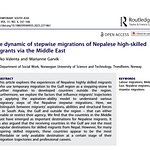Thapa-Oli, S.; Yang, P.Q. The Nepalese Diaspora and Adaptation in the United States. Genealogy 2024, 8, 42. https://doi.org/10.3390/genealogy8020042
Introduction
The research paper The Nepalese Diaspora and Adaptation in the United States by Soni Thapa-Oli and Philip Q. Yang provides an in-depth exploration of how Nepalese immigrants navigate life in the United States. With a rapidly growing diaspora, this study sheds light on cultural integration, social structures, marriage trends, identity shifts, and experiences of discrimination. Drawing on data from the U.S. Department of Homeland Security and a targeted online survey, the research offers valuable insights into the complexities of adaptation faced by Nepalese immigrants. This paper is a critical contribution to migration studies, addressing gaps in scholarly literature on Nepalese immigrants in the U.S.
Paper Summary
The paper investigates the growing presence of the Nepalese community in the U.S., highlighting their adaptation across five key dimensions: cultural, structural, marital, identificational, and receptional. The research challenges traditional assimilation theories, suggesting that Nepalese immigrants experience partial assimilation while maintaining strong cultural ties. Using survey data, the study finds that while many Nepalese have adopted aspects of American culture—such as speaking English proficiently and celebrating American holidays—they also maintain strong connections to their heritage, evident in their continued celebration of Hindu festivals, preference for ethnic marriages, and membership in Nepalese organizations.
Structural adaptation varies, with many Nepalese working in diverse environments yet predominantly maintaining social ties within their ethnic group. The study also reveals a mixed reception in American society, with some experiencing prejudice and discrimination, particularly in workplace settings and social interactions. Despite these challenges, the Nepalese community demonstrates resilience and a unique blend of integration and cultural preservation.
Key Takeaways
Rapid Population Growth: The Nepalese diaspora in the U.S. has significantly expanded since 2000, driven by factors such as the Diversity Visa (DV) Program, asylum applications, and family reunifications.
Partial Assimilation: While Nepalese immigrants have adopted aspects of American culture, they retain strong ethnic traditions, community ties, and language preferences.
Structural Adaptation Challenges: Many Nepalese immigrants maintain social circles within their community, limiting integration into broader American social networks.
Ethnic Retention in Marriage: The majority prefer to marry within their ethnic group, though openness to interracial marriage is gradually increasing.
Identity and Belonging: Most Nepalese identify strongly with their heritage, though some adopt hyphenated identities like “Nepalese-American.”
Experiences of Discrimination: While government treatment is generally perceived as fair, many Nepalese face workplace prejudice, social exclusion, and misidentification as other ethnic groups.

Excerpts and Reviews
The study emphasizes the complexity of Nepalese adaptation, illustrating a dual reality of cultural retention and gradual integration. It highlights the significance of ethnic organizations in preserving Nepalese identity, where community events, religious festivals, and Nepali-language interactions foster a sense of belonging. A compelling finding is the generational shift in identity perception—while first-generation immigrants maintain strong Nepalese identities, the younger generation exhibits a more hybrid cultural outlook.
Scholars reviewing this research have noted its valuable contribution to diaspora studies, particularly for underrepresented communities like the Nepalese. The use of survey data provides empirical depth, while the paper’s critique of assimilation theories positions it as a significant reference for immigration scholars. Overall, The Nepalese Diaspora and Adaptation in the United States is a must-read for those interested in migration patterns, cultural pluralism, and the evolving nature of identity in transnational communities.
Details: Source:








